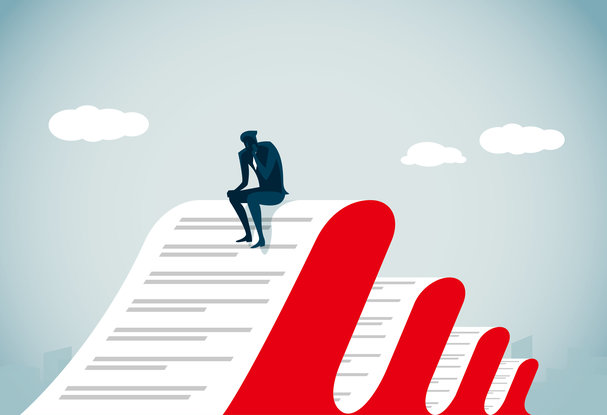
Credit: erhui1979/Getty Images
Researchers reveal the emotional and professional cost of drawn-out peer review
It can have a noticeable effect on a person's career.
10 March 2020

erhui1979/Getty Images
The often-lengthy timeframe for peer review can make life difficult for early-career researchers in particular, who feel their careers are on hold in the months or even years it takes for a paper to be rejected or accepted.
But there are efforts to speed up peer review, to ensure the timely communication of new research.
Publishers, including the UK's Royal Society of Chemistry, are now rewarding their most prolific peer reviewers, and professional societies such as the American Chemical Society have introduced online lessons to expand the pool of peer reviewers to include early-career researchers.
The burden of peer review falls on relatively few volunteers, according to a 2016 PLOS One paper. On average, 20% of scientists are performing up to 95% of all journal-solicited peer reviews, and senior scientists are especially overworked.
Nature Index spoke to four researchers across different fields about the effect of long peer review timeframes, and how things could improve.
Ludmil Alexandrov, Computational Biologist
University of California, San Diego, United States
How long did it take: "There is a norm that peer-review time in top journals is increasing. We had a recent example of a manuscript being rejected after 1.5 years of review. The manuscript was then reviewed for more than a year by another journal before being published. Reviewers in top journals tend to ask for a significant amount of additional experiments that rarely affect the main message of the manuscript."

Ludmil Alexandrov
How it affected me: "The delay in peer review has affected my career. It's hard to apply for grants and move on to new projects before publishing previous results. Getting a new job (such as a faculty position) depends on a good publication record and it's hard to have one if papers are under review for years.
The main effect on science is that the papers published in top journals are usually old news, as we can now read them on bioRxiv much earlier. For example, most of the Pan-Cancer Analysis of Whole Genomes (PCAWG) papers were on bioRxiv in 2018 and, while a lot of additional work has been done to address reviewers' comments, these papers have very similar messages to the ones found in the preprints."
What could be better: "Many researchers post preprints, which can get picked up by social media and informally debated by top scientists in the field. The process for peer review should be re-evaluated in the age of preprints."
William Chen, Mathematician
Ben-Gurion University of the Negev, Israel
What happened: “My manuscript was submitted in the fall of 2016, and two years later, when an inquiry was made to the status to the manuscript, there was no answer. Finally, in late 2019, another editor was contacted, and the manuscript was resubmitted to the same journal. Between 2016 to 2018, the [original] editor cut off contacts with the journal and other editors [for unclear reasons].”

William Chen
How it affected me: "The manuscript was a big part of my PhD dissertation, and not [yet] having it published negatively affected my career prospects. It certainly dissuaded me from continuing that line of research. On a larger note, the long review time also slows down progress in my field and diminishes its reputation."
What could be better: "Reviewers could be given guidelines on how long peer review should take. As the standards in mathematics are quite high, and rigorous reviewing is a substantial effort, incentives for a timely review might help. It might also be useful for reviewers to communicate with the authors through an anonymous system during peer review, because maths papers can become very technical."
Matthew Gebbie, Chemical Engineer
University of Wisconsin-Madison, United States
How long did it take: "My paper took more than a year from submission to acceptance. The wait that felt the longest was the two months' delay between submission and the initial comments. A typical timeline for my field is about one to two weeks for editorial decisions and two to three weeks for referee comments.
The resubmission process took an additional 10 months, because we were requested to expand the scope of the study by performing more experiments."

Matthew Gebbie
How it affected me: "The additional experiments we did were useful for the bio-adhesion community, but this delay occurred when I was transitioning between my graduate and postdoctoral studies, which is a critical time to compete for fellowships and jobs. The uncertainty was stressful. I had dedicated numerous hours to this work, and was unsure about whether I would be rewarded if my paper was not accepted in time for specific competitions."
What could be better: "Editors could consider writing short statements when young researchers apply for jobs, or give awards 'certifying' that a paper is under review and is of broad perceived interest."
Junjia Ye, Geographer
Nanyang Technological University (NTU), Singapore
What happened: "My paper took about eight months from submission to first decision. The typical peer-review time for this journal is three to four months. My sense is that the journal had difficulty finding appropriate reviewers because my research topic on migration and urban diversity in Southeast Asia was just gaining traction at that time."

Junjia Ye
How it affected me: "The wait was long, but the editor was supportive, and his inputs sharpened my argument. Although I was unable to submit my manuscript for consideration elsewhere during the review period, the journal is highly regarded in my field. This, in addition to the editor's encouragement, made me feel that the wait was worth it."
What could be better: "A helpful way to reduce peer-review time is for journals to request potential reviewers from authors. While I can foresee the potential for bias, the editor still has the decision to consider other reviewers, except there is now input from the authors."

